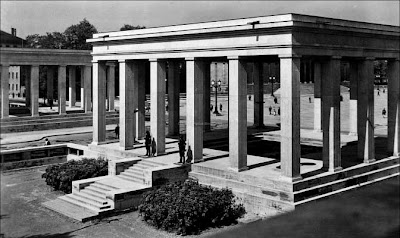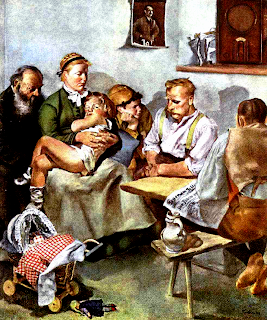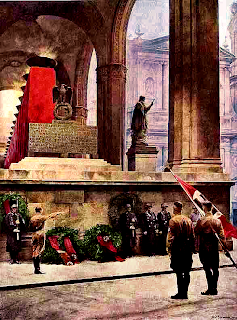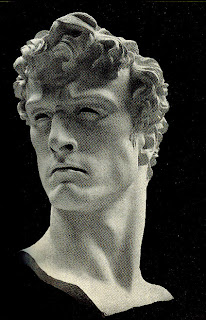 |
| © Copyright Peter Crawford 2013 |
 |
| Hitler Speaks at the Das Haus der Deutschen Kunst München |
 |
| Tag der Deutschen Kunst - München - 1939 |
Das Haus der Deutschen Kunst was constructed from 1933 to 1937 following plans of architect Paul Ludwig Troost as the Third Reich's first monumental structure of National Socialist architecture.
The museum was opened in 18 July 1937 as a showcase for Germany's finest art.
 |
| Tag der Deutschen Kunst - München - 1939 |
The inaugural exhibition was the 'Große Deutsche Kunstausstellung' ("Great German art exhibition"), which was intended as an edifying contrast to the condemned modern art on display in the concurrent 'Degenerate Art Exhibition'.
On 15 and 16 October 1939, the 'Große Deutsche Kunstausstellung', inside the Haus der Deutschen Kunst, was complemented by the monumental 'Tag der Deutschen Kunst' celebration of "2,000 years of Germanic culture" where draped floats (one of them carrying a 5 meter tall golden Reichsadler) and thousands of party activists, in historical costumes, paraded down Prinzregentenstraße for hours in the presence of Adolf Hitler, Hermann Göring, Joseph Goebbels, Heinrich Himmler, Albert Speer, Robert Ley, Reinhard Heydrich, and many other high-ranking members of the government, with minor events taking place in the Englischer Garten nearby.
 |
| Haus der Deutschen Kunst - München Main Fascade - Prof Paul Troost ___________________________________________________ |
 |
| Prof Paul Ludwig Troost |
Paul Ludwig Troost (17 August 1878 – 21 January 1934), born in Elberfeld, was a German architect. An extremely tall, spare-looking, reserved Westphalian with a close-shaven head, Troost belonged to a school of architects, Peter Behrens and Walter Gropius who, even before 1914, reacted sharply against the highly ornamental Jugendstil, and advocated a restrained, classic architectural approach, almost devoid of ornament, combining Spartan traditionalism with elements of modernity.
He became Hitler's foremost architect, whose neo-classical style became the official architecture of the Third Reich.
His work filled Hitler with enthusiasm, and he planned and built state and municipal edifices throughout Germany.
In the autumn of 1933, he was commissioned to rebuild and refurnish the Chancellery residence in Berlin.
 |
| Hitler and Frau Troost at the Haus der Deutschen Kunst |
 |
| Prof Paul Ludwig Troost |
Along with other architects, Troost planned and built State and municipal edifices throughout the country, including new administrative offices, social buildings for workers and bridges across the main highways.
One of the many structures he planned before his death was the 'House of German Art' in Munich, intended to be a great temple for a "true, eternal art of the German people". Hitler's relationship to Troost was that of a pupil to an admired teacher.
Hitler frequently declared, according to Speer, that "he first learned what architecture was from Troost"'.
The architect's death on 21 January 1934, after a severe illness, was a painful blow, but Hitler remained close to his widow Gerdy Troost, whose architectural taste frequently coincided with his own, which made her "a kind of arbiter of art in Munich."
Hitler posthumously awarded Troost the German National Prize for Art and Science in 1936.
 |
| Haus der Deutschen Kunst - München Interior - Prof Paul Troost |
 |
| Haus der Deutschen Kunst - München Main Fascade - Prof Paul Troost |
 |
| Ehrentempel - Königsplatz - München - Paul Troost |
The Ehrentempel ("honor temples") were two structures in Munich, erected in 1935,
housing the sarcophagi of the sixteen members of the party
who had been killed in the failed Munich Putsch.
The martyrs of the movement were in heavy black sarcophagi
in such a way as to be exposed to rain and sun from the open roof.
The pedestals of the temples are seventy feet wide.
The columns of the structures each extended twenty-three feet.
The combined weight of the sarcophagi was over 2,900 pounds.
 |
| Ehrentempel - Königsplatz - München - Paul Troost |
 |
| Ehrentempel - Königsplatz - München - Paul Troost |
click below for more information and images
 |
| © Copyright Peter Crawford 2013 |
___________________________________________________
 |
| Zeitungsleser Otto Kirchner (1887 – 1960) |
 |
| Bäuerliche Venus - 1939 Sepp Hilz |
 |
| Bäuerliche Venus - 1939 Sepp Hilz |
 |
| Die rote Halskette - 1942 Sepp Hilz |
 |
| Eitelkeit - 1940 Sepp Hilz |
 |
| Die vier Elemente - The Four Elements Adolf Ziegler |
 |
| Die vier Elemente - The Four Elements Adolf Ziegler |
 |
| Working Maidens - 1940 Leopold Schmutzler |
 |
| Der Fuehrer Spricht - 1939 Paul Matthias Padua |
 |
| Bauernfamilie Adolf Wissel |
 |
| Erbhofbauer |
 |
| Liegender Frauenakt - Reclining Female Nude Ernst Liebermann |
 |
| Dianas Ruhe - Diana's Rest Ivo Saliger |
 |
| Frauenakten - Female Nudes Ivo Saliger |
 |
| Weiblicher Akt Leopold Schmutzler |
 |
| Weiblicher Akt im Meer Karl Truppe |
 |
| Mädchen mit einer Sonnenblume Karl Truppe |
 |
| Leda und der Schwan Paul Matthias Padua |
 |
| Und ihr habt doch Gesiegt Paul Hermann - 1942 |
 |
| Alter Kämpfer - 9th November 1923 |
___________________________________________________
 |
| Bereitschaft Arno Breker |
Consider Arno Breker's Readiness.
A muscular male nude with a body seemingly perfect.
Its debt to classical sculpture suggests that the ideal it represents is an eternal one, to which we must aspire but that we may not judge, while its proportions suggest a calm but obvious fierceness.
Such unblemished forms are stripped of all individualizing defects, - stripped of their singularity as specific humans to which the viewer might respond. Instead, they are archetypes, with abstract titles like 'Readiness' or 'Comradeship', "worthy" of Hitler's call for an "eternal" art that would express immutable Aryan values.
 |
| Adolf Wamper Genius des Siegers |
 |
| Danziger Freiheitskämpfer Josef Thorak |
Josef Thorak (7 February 1889 in Salzburg – 26 February 1952) was an Austrian-German sculptor.
In 1933 Thorak joined Arno Breker as one of the two "official sculptors" of the Third Reich.
In his studio outside Munich, Thorak worked on statues intended to represent the folk-life of the German Volk.
These works tended to be heroic in scale, up to 65 feet (20 meters) in height.
His official works from this period included a number of sculptures at the Berlin Olympic Stadium of 1936.
Some expressionist influences can be noticed in his neoclassical style.
 |
| Männliche und weibliche Akt Josef Thorak |
 |
| Murcur Fritz Klimsch |
 |
| Eos Arno Brteker |
 |
| Kniend Krieger - 1937 Richard Scheibe |
 |
| Nach dem Kampf Hans Bühler |
 |
| Bauer Jacob Wilhelm Fehrle |
 |
| Männlicher Akt Fritz Klimsch |
 |
| Männer in der Ausbildung Anton Grauel |
 |
| Der Stürmer Arno Breker |
Arno Breker (July 19, 1900 – February 13, 1991) was a German sculptor, best known for his public works in the Third Reich, which were endorsed by the authorities as the antithesis of degenerate art.
He was born in Elberfeld, and died in Düsseldorf.
The neoclassical nature of his work, with titles like 'Comradeship', 'Torchbearer', and 'Sacrifice', typified National Socialist ideals, and suited the characteristics of the architecture of the Third Reich.
The proportions of his figures, the highly colouristic treatment of his surfaces (the strong contrasts between dark and light accents), and the melodramatic tension of their musculatures invites comparison with the Italian Mannerist sculptors of the 16th century.
This Mannerist tendency to Breker's neoclassicism may suggest close affinities to expressionist tendencies in German Modernism.
 |
| Der arischen Rasse Arno Breker |
 |
| Kameradschaft Arno Breker |
 |
| Der Racher Arno Breker |
 |
| Der Bannertrager Arno Breker |
 |
| Sterbende Krieger Arno Breker |
 |
| Abfahrt zur Schlacht Arno Breker |
Kampf
Arno Breker
 |
| Das Urteil des Paris Arno Breker |
 |
| Du und Ich Arno Breker |
 |
| Euridice und Orpheus Arno Breker |
 |
| Daphne und Apollo Arno Breker |
 |
| Thanatos Arno Breker |
 |
| Arischen Menschen Arno Breker |
 |
| Heroischen Kopf Arno Breker |
| Richard Wagner Arno Breker |



+-+Paul+Ludwig+Troost+-+Occult+Reich+-+Peter+Crawford.jpg)



